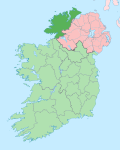This article needs additional citations for verification .(December 2009) |
Ardagh, County Donegal | |
|---|---|
Townland | |
 | |
| Country | Ireland |

Ardagh (Irish : Ardachadh, meaning 'high field') is a townland in the fertile district known as the Laggan in East Donegal, part of County Donegal, Ireland. [1] It is very near St Johnston. It became part of the large Abercorn Estate and was settled by mainly Lowland Scots settlers during the Plantation of Ulster.
